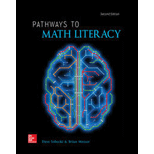
Concept explainers
Carefully read through the list of terminology we’ve used in Unit 3. Consider circling the terms you aren’t familiar with and looking them up. Then test your understanding by using the list to fill in the appropriate blank in each sentence.
building up
conditional equation
direct variation
equation
equivalent
equivalent equations
exchange rate
generalizing
inequality
line of best fit
linear equation
literal equation
proportion
rate of change
slope
solution
solution to a system
solving a system
system of equations
terms
x intercept
y intercept
An _______________ is simply a statement that two quantities are equal.
Want to see the full answer?
Check out a sample textbook solution
Chapter 3 Solutions
Pathways To Math Literacy (looseleaf)
- 5. Find the derivative of f(x) = 6. Evaluate the integral: 3x3 2x²+x— 5. - [dz. x² dx.arrow_forward5. Find the greatest common divisor (GCD) of 24 and 36. 6. Is 121 a prime number? If not, find its factors.arrow_forward13. If a fair coin is flipped, what is the probability of getting heads? 14. A bag contains 3 red balls and 2 blue balls. If one ball is picked at random, what is the probability of picking a red ball?arrow_forward
- 24. What is the value of ¿4, where i 25. Simplify log2 (8). = −1? 26. If P(x) = x³- 2x² + 5x - 10, find P(2). 27. Solve for x: e2x = 7.arrow_forward9. Solve the differential equation: 10. Find the general solution of dy + y = 0. dy 33 dx 3x².arrow_forward3. Differentiate f(x) = x² sin(x). 4. Evaluate the limit: sin(2x) lim xarrow_forward
- 1. Solve for x in the equation: 2. If A = (1/3 2/) 4 x³-3x²+4=0 find the determinant of A.arrow_forwardListen ANALYZING RELATIONSHIPS Describe the x-values for which (a) f is increasing or decreasing, (b) f(x) > 0 and (c) f(x) <0. y Af -2 1 2 4x a. The function is increasing when and decreasing whenarrow_forwardBy forming the augmented matrix corresponding to this system of equations and usingGaussian elimination, find the values of t and u that imply the system:(i) is inconsistent.(ii) has infinitely many solutions.(iii) has a unique solutiona=2 b=1arrow_forward3/4+1/2=arrow_forwardif a=2 and b=1 1) Calculate 49(B-1)2+7B−1AT+7ATB−1+(AT)2 2)Find a matrix C such that (B − 2C)-1=A 3) Find a non-diagonal matrix E ̸= B such that det(AB) = det(AE)arrow_forward1.2.17. (!) Let G,, be the graph whose vertices are the permutations of (1,..., n}, with two permutations a₁, ..., a,, and b₁, ..., b, adjacent if they differ by interchanging a pair of adjacent entries (G3 shown below). Prove that G,, is connected. 132 123 213 312 321 231arrow_forwardarrow_back_iosSEE MORE QUESTIONSarrow_forward_ios
 Glencoe Algebra 1, Student Edition, 9780079039897...AlgebraISBN:9780079039897Author:CarterPublisher:McGraw Hill
Glencoe Algebra 1, Student Edition, 9780079039897...AlgebraISBN:9780079039897Author:CarterPublisher:McGraw Hill Algebra for College StudentsAlgebraISBN:9781285195780Author:Jerome E. Kaufmann, Karen L. SchwittersPublisher:Cengage Learning
Algebra for College StudentsAlgebraISBN:9781285195780Author:Jerome E. Kaufmann, Karen L. SchwittersPublisher:Cengage Learning Intermediate AlgebraAlgebraISBN:9781285195728Author:Jerome E. Kaufmann, Karen L. SchwittersPublisher:Cengage Learning
Intermediate AlgebraAlgebraISBN:9781285195728Author:Jerome E. Kaufmann, Karen L. SchwittersPublisher:Cengage Learning Holt Mcdougal Larson Pre-algebra: Student Edition...AlgebraISBN:9780547587776Author:HOLT MCDOUGALPublisher:HOLT MCDOUGAL
Holt Mcdougal Larson Pre-algebra: Student Edition...AlgebraISBN:9780547587776Author:HOLT MCDOUGALPublisher:HOLT MCDOUGAL Trigonometry (MindTap Course List)TrigonometryISBN:9781305652224Author:Charles P. McKeague, Mark D. TurnerPublisher:Cengage Learning
Trigonometry (MindTap Course List)TrigonometryISBN:9781305652224Author:Charles P. McKeague, Mark D. TurnerPublisher:Cengage Learning Functions and Change: A Modeling Approach to Coll...AlgebraISBN:9781337111348Author:Bruce Crauder, Benny Evans, Alan NoellPublisher:Cengage Learning
Functions and Change: A Modeling Approach to Coll...AlgebraISBN:9781337111348Author:Bruce Crauder, Benny Evans, Alan NoellPublisher:Cengage Learning





